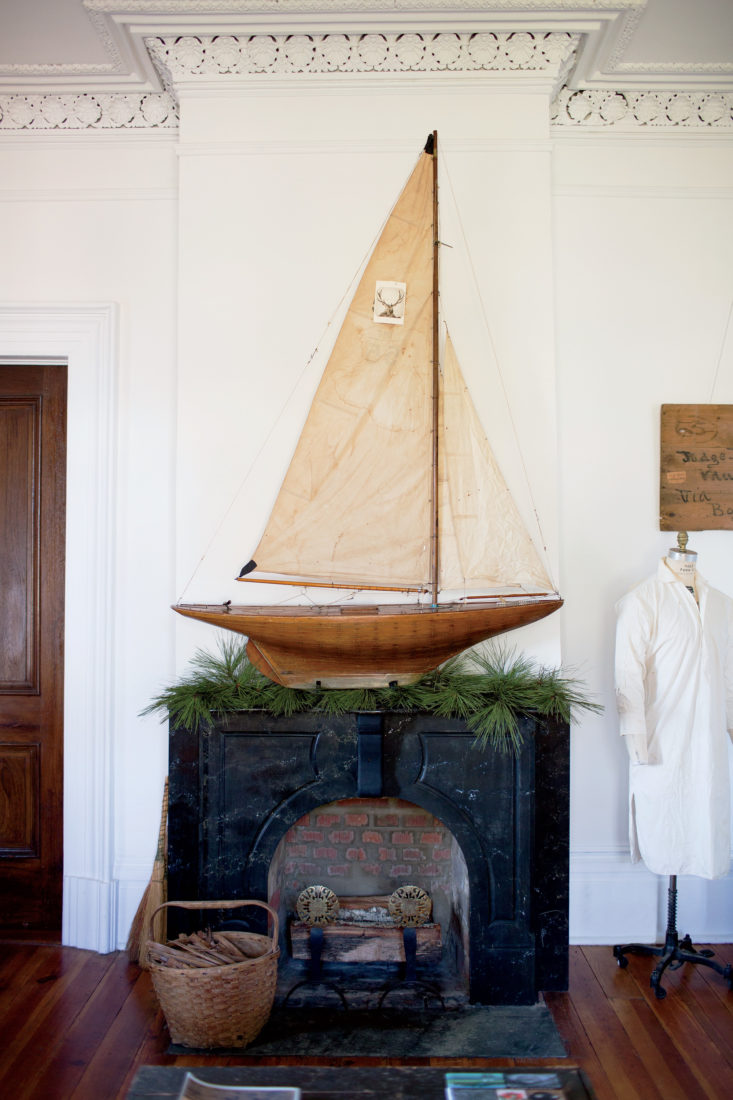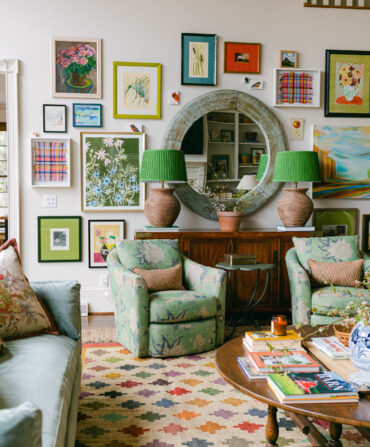The words are etched into the wood of an interior barn door, on the outside of a room that probably once held grain:
WILLIAM E. WATSON
THE YEAR 1904 JANUARY
ROBERT E. WATSON
The writing is not pretty—or even all that horizontal. The letters go all over the place. It’s rough. But that doesn’t really matter. It’s history—cut into a door by people who lived here.
“You know, it’s funny,” says Kenny Long Thomas, who, along with his partner, Leeta Harding, has spent the last three-plus years restoring the barn and its attending main house and outbuildings. “I mean, it was like them saying: ‘We’re here.’ I also have a note by them,” he says, “asking about the number of goats on the farm—father to son.”
Thomas is dressed in torn and ratty khakis and a white T-shirt with a light gray cardigan over it. His black-rimmed eyeglasses are tilted up on his forehead. He hooks his left thumb toward a horse stall behind him, where thousands of household documents that have yet to be organized sit in cardboard banker’s boxes. “I mean, they obviously loved it,” he says. “And they carved their names into this door.”
Harding and Thomas moved into the house in 2009. A photographer, Harding met Thomas, a former vice president of design at Polo Ralph Lauren, in New York after he decided to learn photography. Not long after, they embarked on a road trip across America. As they were finishing up two years of traveling, Thomas’s cousin suggested they stop by the family’s old stomping ground, near Seaboard, North Carolina. Next thing the couple knew, they were buying a slightly tumbledown Victorian-era spread—ornate and with great bone structure, big lawns, and original buildings—in the nearby town of Murfreesboro. “We really loved the story of the place,” Harding says.
To get to the property—technically known as the David A. Barnes House in the historical register—you have to travel a bit. You take a right not too long past the Gurganus Peanut Outlet, and then it’s still a half-hour drive. You cross out of Virginia and into North Carolina, where the house sits. By the time you get close, the landscape has gone from fields of soybeans and cornstalks to huge expanses of cotton plants. You’re deep in the South now.

Photo: Patricia Lyons
Warm Welcome
Cleo guards the main hallway.
David A. Barnes was a judge in town. The house—a Victorian foursquare masterwork set on seven acres—has a pair of up and down staircases (common to homes with servants), eight fireplaces, and porches off the sides. In addition to the hay barn, the outbuildings include a two-horse stable, two cabins the couple plans to eventually fix up for guests, and a four-hole privy close to the back door. There are big swaths of grass. And a smokehouse.
No question about it: Barnes and his builders made a nice place to live. Over time and subsequent generations, however, it started to get worn down. Then Harding and Thomas showed up and set about remaking the buildings while preserving the home’s character. They worked with local and state historical officials to get the property protected as a historic site, and found artisans to fix the ornate ceramic ceiling moldings that had broken and fallen out in sections. They refurbished the carved-wood fleur-de-lis that hang down from the outer edges of one porch roof. The woodwork had slowly deteriorated over the years. Now it’s a stylish touch that fits. They also replaced the roof, made the outbuildings structurally sound, and restored the walls, all of which are made from plaster and lath, a design element worth respecting in a drywall and spec-house world.

Photo: Patricia Lyons
A portrait of the original owner hangs in the front hallway.
Even with the updates—which also include new cabinetry and a restaurant-style stove in the kitchen—they’ve kept the feel of the house intact. “The historical officials allowed that we could put a deck off the back,” Thomas says. “But we used local bricks to support it. We’ve tried to keep it honest.” On the walls, Harding’s photos hang alongside old portraits of family—not to mention a borrowed painting of the judge near the front door. The decor is rustic and elegant and authentic, peppered with flea market finds, comfortable furnishings, hardcover books, and antique brass door hardware restored to its original condition. “I just like old things,” Thomas says.
And now, Thomas has a new clothing and accessories company to run, partially from the house, called Grayers: a post–World War II British term that comes from men who stopped wearing business suits and started wearing gray flannel trousers with tweed sport coats to their offices. The line is a collaboration between Thomas and another former Polo vice president, Peter Georgiou. “Peter and I make what we want to wear,” Thomas says. There are shirts in a range of plaids; trousers in khaki and flannel; and a blue blazer made of wool that is as much like a sweater as a jacket.
Is it hard to run a new company, with outlets on two continents already, from a small town in deeply rural North Carolina? “I travel,” Thomas says. “The nearest airport is two hours away. I use a lot of Skype.” He’ll be leaving in two days for a multi-week trip, and you can see on his face that he both wants to go—to make his new business fly higher—and not to go, as he likes being with the house and with Harding and their nearly two-year-old son, Tate. Then he smiles. “I may have to leave for a few weeks,” Thomas says, “but then I’m…home.”









